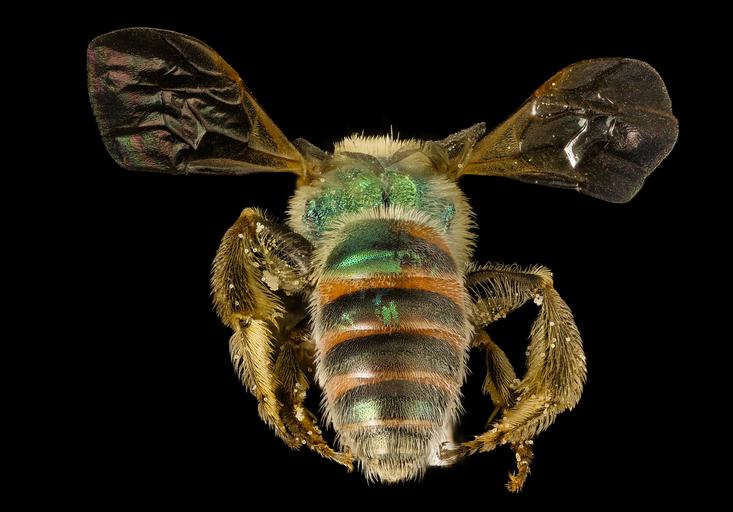MAKE A MEME
View Large Image

| View Original: | Agapostemon_texanus.angelicus,_gynandromorph,_NM,_Hidalgo_co,_back_2016-06-08-13.43.jpg (5376x3754) | |||
| Download: | Original | Medium | Small | Thumb |
| Courtesy of: | www.flickr.com | More Like This | ||
| Keywords: zerene stacker zerenestacker stackshot geological survey geologicalsurvey united states geological survey unitedstatesgeologicalsurvey department of the interior departmentoftheinterior droege biml bee inventory and monitoring laboratory beeinventoryandmonitoringlaboratory canon close-up closeup macro insect bug patuxent wildlife research center patuxentwildliferesearchcenter pwrc usgs dofstacking stacking bee bees apoidea hymenoptera taxonomy:genus=agapostemon arizona hermaphrodite gynandromorph tim mcmahon timmcmahon elizabeth garcia elizabethgarcia halictidae black background indoor surreal Hermaphrodite! (aka a gynandromorph) This Agapostemon texanus or angelicus (species can't be determined here) is part male and part female. This happens in I think all animals and I have seen about 5 of these after looking at about 400,000 bee specimens. This one was brought in by Tim McMahon after he collected it in Arizona. Mostly this specimen is female in aspect except for the following: Half of the clypeus (the front plate of the head) is male, half female (bilaterally) similarly one mandible is male and one female. The male has 6 tergites like the female, but the coloration is mostly male, which is brownish, but, interestingly there are some spots on the abdomen that are metallic green which is female. Photographs by Elizabeth Garcia. ~~~~~~~~~~{{{{{{0}}}}}}~~~~~~~~~~ All photographs are public domain, feel free to download and use as you wish. Photography Information: Canon Mark II 5D, Zerene Stacker, Stackshot Sled, 65mm Canon MP-E 1-5X macro lens, Twin Macro Flash in Styrofoam Cooler, F5.0, ISO 100, Shutter Speed 200 Beauty is truth, truth beauty - that is all Ye know on earth and all ye need to know " Ode on a Grecian Urn" John Keats You can also follow us on Instagram - account = USGSBIML Want some Useful Links to the Techniques We Use? Well now here you go Citizen: Art Photo Book: Bees: An Up-Close Look at Pollinators Around the World www.qbookshop.com/products/216627/9780760347386/Bees.html... Basic USGSBIML set up: www.youtube.com/watch?v=S-_yvIsucOY USGSBIML Photoshopping Technique: Note that we now have added using the burn tool at 50% opacity set to shadows to clean up the halos that bleed into the black background from "hot" color sections of the picture. www.youtube.com/watch?v=Bdmx_8zqvN4 PDF of Basic USGSBIML Photography Set Up: ftp://ftpext.usgs.gov/pub/er/md/laurel/Droege/How%20to%20Take%20MacroPhotographs%20of%20Insects%20BIML%20Lab2.pdf Google Hangout Demonstration of Techniques: plus.google.com/events/c5569losvskrv2nu606ltof8odo Excellent Technical Form on Stacking: www.photomacrography.net/ Contact information: Sam Droege [email protected] 301 497 5840 Hermaphrodite! (aka a gynandromorph) This Agapostemon texanus or angelicus (species can't be determined here) is part male and part female. This happens in I think all animals and I have seen about 5 of these after looking at about 400,000 bee specimens. This one was brought in by Tim McMahon after he collected it in Arizona. Mostly this specimen is female in aspect except for the following: Half of the clypeus (the front plate of the head) is male, half female (bilaterally) similarly one mandible is male and one female. The male has 6 tergites like the female, but the coloration is mostly male, which is brownish, but, interestingly there are some spots on the abdomen that are metallic green which is female. Photographs by Elizabeth Garcia. ~~~~~~~~~~{{{{{{0}}}}}}~~~~~~~~~~ All photographs are public domain, feel free to download and use as you wish. Photography Information: Canon Mark II 5D, Zerene Stacker, Stackshot Sled, 65mm Canon MP-E 1-5X macro lens, Twin Macro Flash in Styrofoam Cooler, F5.0, ISO 100, Shutter Speed 200 Beauty is truth, truth beauty - that is all Ye know on earth and all ye need to know " Ode on a Grecian Urn" John Keats You can also follow us on Instagram - account = USGSBIML Want some Useful Links to the Techniques We Use? Well now here you go Citizen: Art Photo Book: Bees: An Up-Close Look at Pollinators Around the World www.qbookshop.com/products/216627/9780760347386/Bees.html... Basic USGSBIML set up: www.youtube.com/watch?v=S-_yvIsucOY USGSBIML Photoshopping Technique: Note that we now have added using the burn tool at 50% opacity set to shadows to clean up the halos that bleed into the black background from "hot" color sections of the picture. www.youtube.com/watch?v=Bdmx_8zqvN4 PDF of Basic USGSBIML Photography Set Up: ftp://ftpext.usgs.gov/pub/er/md/laurel/Droege/How%20to%20Take%20MacroPhotographs%20of%20Insects%20BIML%20Lab2.pdf Google Hangout Demonstration of Techniques: plus.google.com/events/c5569losvskrv2nu606ltof8odo Excellent Technical Form on Stacking: www.photomacrography.net/ Contact information: Sam Droege [email protected] 301 497 5840 | ||||